|
BACK ON THE ROAD AGAIN
Stu's Super-Awesome DS Review Roundup (Part 1)
When one is at least nominally a videogames journalist, keeping up with the times is a duty rather than a hobby. It's a reviewer's professional responsibility to understand context, by whatever means are available, and thereby appraise any game they review relative to its present peers and competitors. (Otherwise every game would score 10/10 on the grounds that it's a lot better than the Atari VCS version of Pac-Man. Unless it was Tomb Raider Legend, obviously.) It was with that duty in mind that your correspondent recently fearlessly invested his own money in a lovely G6 Lite flash cart, and has been working through the entire catalogue of Nintendo's beautiful DS Lite with it ever since. Here's the first report.
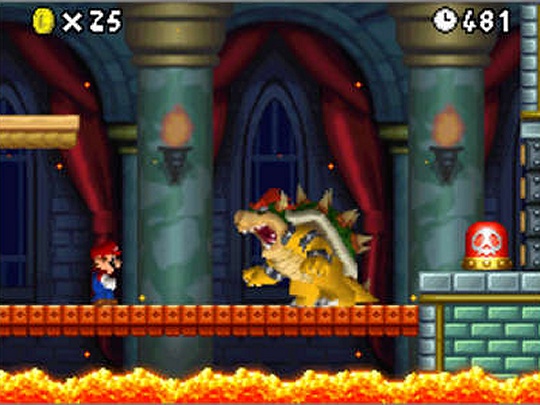
Mario faces off with Bowser one more time. You can still just jump right over the silly old fool.
NEW SUPER MARIO BROS (Nintendo)
You probably won't need telling just how lovely this is. Basically a retrograde step from the complexities of the later games in the series (SMB3, Super Mario World and Yoshi's Island) and back to the basics of the first Super Mario Bros, but pepped up with beautiful 3D graphics and all manner of fancy DS trickery, this is Mario doing what he does best.
It looks and feels so gorgeous that it's possible to overlook the slight over-familiarity, and the extreme easiness of simply playing through it (it gives powerups and extra lives away like sweeties) is tempered by the difficulty of collecting all the Star Coins and finding all the worlds and routes, without which you of course can't even remotely claim to have completed the game properly. There's almost no use of the touch screen or even the second screen, and perhaps as a result New SMB hasn't actually been one of my most-played DS games - the lack of challenge, certainly in the first half, makes it less compelling than you might think (as you actually find yourself slightly reluctant to play it because you don't want it to be over too quickly), and it's also hampered by a pointlessly annoying save mechanism. But still, quality simply drips from every joint, pore and extremity, and owning a DS without a copy of New Super Mario Bros would be reckless to the point of perversity. 9/10
------------------------------------------------------------------------------------------
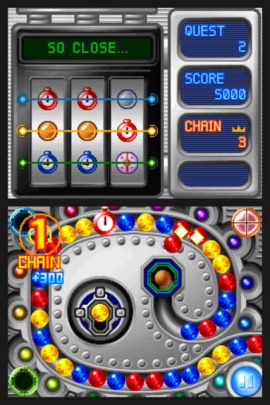 
Left: Magnetica. Right: Super Princess Peach. Obviously.
MAGNETICA (Nintendo) (released
in Europe as ACTIONLOOP)
I was never a very big fan of either Puzz Loop (the original Mitchell Corporation arcade game, released to home gamers on the PS1, to which this is a sequel) or Zuma Deluxe, the highly successful PC ripoff of it by PopCap Games. The coin-op translates badly to console or emulator play due to the unsuitability of joypads for replicating the rotational control, and the mouse-based Zuma is so absurdly, insanely easy that on my very first go it took me nearly two hours to lose a single life. My low expectations for Magnetica, then, were pretty comprehensively smashed to pieces when it turned out to be a near-perfect DS game.
The touch-screen and stylus combo is a dream control method, enabling instant, accurate marble-flinging without a moment's thought, and the three game modes provide a perfect slice of fun for every occasion. There's the manic arcade play of Challenge mode (a rapidly-frantic single-level high score game), the excellently varied stages of Quest mode (dozens of individual levels with different features and finite numbers of marbles to clear), and the severe mental torment of Puzzle mode (60 static rounds where you have three or four marbles with which to completely clear a preset formation, and which rapidly gets agonisingly difficult). Magnetica will adeptly occupy exactly the amount of time you have to kill - no matter how much or how little that is - with one of its three very different games, and there's so much of it that it'll do so for weeks and months. It's wonderful. 9/10
------------------------------------------------------------------------------------------
SUPER PRINCESS PEACH (Nintendo)
This Mario-for-kids platformer certainly looks the part with its ultra-cutesy pastel graphics and friendly-looking characters (including all the baddies), and the power-up system based on Peach's girly emotions (make her cry to water a beanstalk which she can then climb up, for example) is twee-ly inventive. But the game - which is more closely related to the Game Boy's series of Wario Land titles than to the Mario platform line - is fiddly and unsatisfying, lacking focus and involving an awful lot of retracing of steps before it grudgingly gives up the items necessary to overcome its simple obstacles. It's mildly engaging in play, but the near-total absence of challenge will eventually bore even the kids it's aimed at. 4/10
------------------------------------------------------------------------------------------
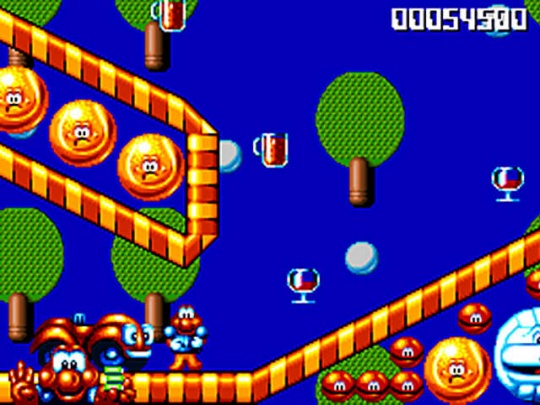
Turn a DS Lite's brightness to the max while playing Robocod and you'll probably X-ray yourself.
JAMES POND: CODENAME ROBOCOD (Play It)
The original Robocod was an inexplicably popular third-rate Sonic wannabe on the Amiga 15 years ago, but this port of a GBA "conversion" shares very little with its parent. The levels have been completely redesigned, the speed (both in terms of direct movement and progress through a level) has been substantially hiked, and a significant zooming-out of the camera compared to the GBA version combined with the addition of a map display on the second screen revolutionises what was once a gruelling, trial-and-error trek through vast, sprawling levels full of leaps into the unknown (which usually turned out to be a row of deadly spikes), and turns it into something navigable and hence unrecognisably more fun.
(Man, that was quite a sentence. Stop for a minute and catch your breath.)
Robocod on the DS is incredibly shallow yet hugely engrossing. Whereas New Mario is all about zipping through to the end and then going back to hunt down everything you missed, Robocod takes an entirely different (and in many ways directly opposite) approach to the concept of "replay value". Your stockpile of lives is limited (you can have a maximum of four in reserve at any one time, with up to five energy bars) and in short supply, and you can only save after a complete world rather than an individual level. What this means is that you have to conserve your hit points with an almost paranoid care, and if you recklessly lose a life or two on a particular stage, you may well be better going all the way back to the start of the world and doing a better job of it, if you want to carry enough lives over to the next world to have a chance. The levels are so pretty and fast-moving, though, that replaying them a third or fourth time in this way is almost an enjoyable as the first try, and the bonus levels you can unlock by collecting all three golden bells in each stage provide an extra high-score target on top of the daunting challenge of completing all of the 100 or so levels.
For the budget price it's been released at, you'll have a hard time bettering this for value for money on the DS, and nobody's more surprised by that than your correspondent. Much better than the GBA version (thanks to the bigger screen area, the map and the inclusion at last of proper saving rather than passwords), and infinitely better than the Amiga original, Robocod is finally the game that everyone said it was a decade and a half ago. 8/10
------------------------------------------------------------------------------------------
 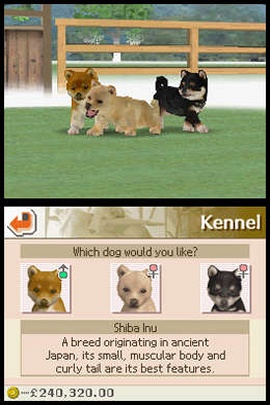
Left: Tetris DS. Right: Nintendogs. You knew that, right?
TETRIS DS (Nintendo)
As this reporter will hopefully reveal in book form one day soon, there's a surprising amount of different stuff you can do with Tetris. There have been well over 50 distinct Tetris games released (NOT counting versions simply ported across multiple formats) and practically every one of them does something unique with Alexey Pajitnov's simple formula. Tetris DS is no exception to that rule - in fact, it's probably more stuffed with new kinds of Tetris than any other version to date. The basic standard game is actually pretty weak, as most Tetris releases are these days since the Tetris Company rewrote Pajitnov's rules to make the game moronically easy and illogical. But Tetris DS has a wealth of much more captivating other modes, particularly the head-scratching Puzzle game and the excellent Push mode (pictured above) where you battle an opponent to push the central wall of blocks into each other's base in a ding-dong back-and-forth battle that can last for 10 or 15 minutes. Throw in the comprehensive array of wi-fi and VS CPU multiplayer options and you've got enough Tetris here to keep you busy for half a lifetime. I still miss the Space Shuttle, though. 8/10
------------------------------------------------------------------------------------------
NINTENDOGS (Nintendo)
Insanely cute, and probably responsible for selling more games machines to non-gamers than any game in history, Nintendogs is the current state of the art in virtual pets. There isn't all that much actual game to it, but there always seems to be something to do, and simply going to the park, seeing what you encounter on the way there and playing with your frisbee or tennis ball is so beautifully executed, and your little mutt so lovable, that you can't find it in yourself to be bored. And hardly anything feels nicer than being stuck somewhere with a few minutes to kill, and using the time to take your happy little puppy for a walk. 7/10
------------------------------------------------------------------------------------------
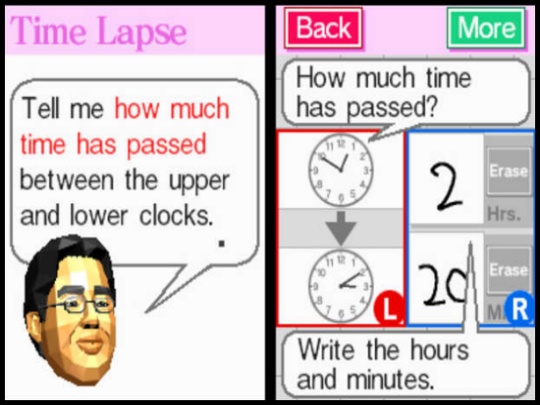
You're wrong not to be excited by this screenshot.
DR KAWASHIMA'S BRAIN TRAINING (Nintendo)
In many ways similar to Nintendogs, not least in that it's designed to be played for no more than five or ten minutes a day, Brain Training is probably the most complete use of the DS technology to date. Whether you're tapping away at a pattern of numbers in Low To High, frantically scribbling down the answers to simple arithmetic in Calculations x 100, or yelling the colours of words into the microphone during Stroop Test, you'll always be doing something that you could only be doing with a DS. Most of it is brilliantly realised, with only very rare errors in voice or handwriting recognition, but it's slightly irritating and out-of-place to have the various tests unlocked so slowly, making play needlessly limited and repetitive and forcing you to do stuff you don't like to unlock the more fun tests. On the other hand, it's the only thing that's ever made me even slightly interested in Sudoku, so bonus points there. I really hope someone makes a Picross game for the DS soon, though. 6/10
------------------------------------------------------------------------------------------
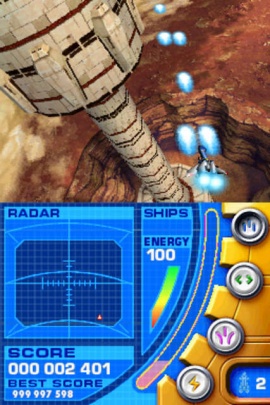 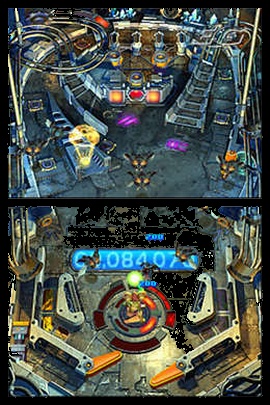
Left: Nanostray. Right: Metroid Prime Pinball. Like, duh.
------------------------------------------------------------------------------------------
NANOSTRAY (THQ)
Conversely, this vertically-scrolling on-rails 3D shmup features some of the most gratuitous, pointless and self-defeating use of the DS touch-screen since Space Invaders Revolution. The extremely pretty and challenging shooter is significantly hampered by the contorted hand positioning required both to play it normally and to lunge at the touch-screen in order to change weapons. So awkward are the various methods provided that you end up just picking your favourite weapon and sticking to it throughout the game, because any benefit of using more appropriate ones at certain times is nullified by the disadvantages of sacrificing proper control over your ship while you select them. It's still a pretty decent little game, but five minutes spent slapping the designer around the head with a wet rolled-up newspaper would have been five minutes well spent on behalf of gamers everywhere. 5/10
------------------------------------------------------------------------------------------
METROID PRIME PINBALL (Nintendo)
Since the halcyon days of the mono Game Boy and the mighty Revenge Of The Gator and Kirby's Pinball Land, handheld owners have been rather poorly served by pinball games. There's been no shortage of releases (particularly on the GBA, which saw at least 10 different pinball titles) but few were any good, and with the partial exception of The Pinball Of The Dead, none came anywhere near scaling the heights of their black-and-white brothers. Metroid Prime Pinball outperforms them all by a distance. With just two basic tables (neither of them enormously complex) and a handful of bonus sections, it seems rather thin on first glance, but extended play reveals a well-crafted and balanced game that provides a convincingly realistic pinball experience while taking advantage of the hardware to do things that wouldn't be possible on a real table (like the frantic shooting sub-games).
Unlike many handheld pinball titles (including most of the GBA ones) it isn't excessively easy, and there's always more stuff to do than you can actually pull off at any given time. You can play the full-blown mission mode or tackle the tables individually for high scores, and it blissfully offers either shoulder-button flipper control or d-pad-and-button options (as per Revenge Of The Gator), rather than taking the massively irritating modern approach of only having the former. One of your reviewer's most-played DS games. 8/10
------------------------------------------------------------------------------------------
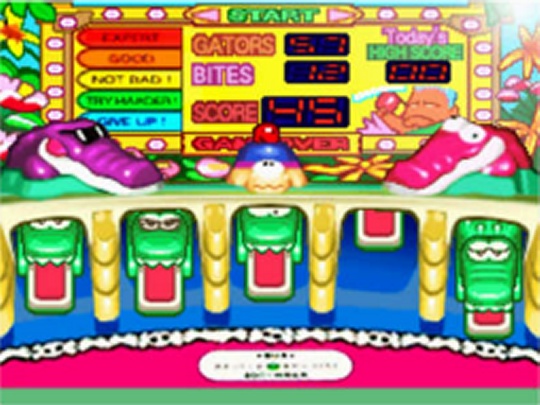
Cartman was sad at being turned into a duck.
POINT BLANK (Namco)
This one's a real shame, though. Namco's various Point Blank titles on the PS1 are (along with the same company's Time Crisis line) the best light-gun games ever made, and it's a source of constant sadness to this reviewer that his super-fancy modern 52-inch telly can't play any of them. So bringing it to the DS seemed a surefire winner - the touch-screen is ideally suited to the accurate-aiming antics and the bite-sized gaming chunks perfect for portable pick-up-and-play. And indeed, in basic execution that's the case (the mini-games adapting superbly to the handheld) but Namco have really let themselves down with the game's structure, and Point Blank DS just doesn't hang together as a cohesive whole.
Idiotically, the game lacks an Endurance mode (where you'd just play levels in a random order for points until you ran out of lives), and the other modes are a structural mess. Arcade has just a single high-score table, encompassing all four difficulty levels from the four-stage Beginner to the eight-stage Insane. Playing the same mode twice running will deliver a completely different selection of games with radically different score potential, so even scores within the same difficulty level aren't comparable, and the table makes no distinction between scores achieved with or without continuing, destroying any possible last chance it had of any kind of meaning. Meanwhile, Free Play mode only allows you to register high scores on single mini-games, and the bandwagon-jumping Brain Massage mode (which is actually to all intents and purposes the central game) only unlocks its later stages if you repeatedly play deliberately badly, which is almost too cretinous for words. Point Blank should be a wonderful game on the DS, but this badly thought-out mess isn't it. 4/10
------------------------------------------------------------------------------------------
 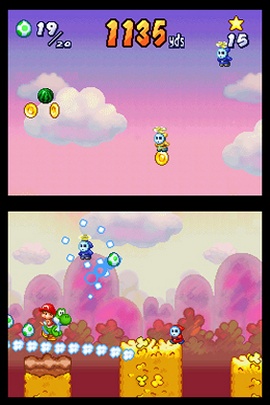
Left: Phoenix Wright. Right: Yoshi Touch & Go. In case you weren't sure.
PHOENIX WRIGHT: ACE ATTORNEY (Capcom)
Here's something very different, a surprisingly isolated release in a genre the DS is ideally suited to - point-and-click adventures. Because under the thin veneer of a lawyer simulator, that's what Phoenix Wright: Ace Attorney actually is. You've got scenes to search, objects to manipulate, and multiple-choice dialogue as you attempt to establish the guilt or innocence of various clients in a series of interconnected cases in a joyously knockabout style.
The courtroom scenes are the best part, as you look for inconsistencies in witness statements and press them for clues, but the game's main failing is in its extreme linearity and slow-witted failure to realise what you're getting at in presenting a piece of evidence if it doesn't expect you to have figured out the answer yet at that point. Too often you have to act dumb and go along with several minutes of laboured plot exposition until the game gets to the point where you're supposed to have realised the solution, and even then it can be a case of randomly presenting items until you find the one that's arbitrarily acceptable as the conclusive evidence. (This is exacerbated by the completely senseless system of "lives" which is used at some points in the game, which can force you to tediously replay earlier sections for no good reason.) It's a mark of how enjoyable PWAA is that you stick with it despite all this, and despite the agonisingly long cutscenes, and the game is powerful support for the argument that something done with enough love and verve will transcend genre boundaries and entertain even people who wouldn't normally like that sort of thing. 6/10
------------------------------------------------------------------------------------------
YOSHI TOUCH & GO (Nintendo)
This has to be the slimmest of all the DS's games - past, present and surely future. An incredibly slight showcase for the touch-screen, it sees you drawing little gossamer clouds with the stylus (in a cute touch, you can also clear mistakes by blowing them away with the mic) across two types of random landscape, first to guide a balloon-borne Baby Mario safely to earth, and then to create a route for egg-firing Yoshi to carry him across gaps and past hazards and enemies to the end of the level.
In truth it feels more like a tech demo than a finished game, an impression reinforced by the way it just doesn't seem to have been quite thought all the way through - it's too thin, repetitive and random for an extended play session, but too slow getting to the action for five minutes in a bus queue, and the twin screens (and more particularly the gap between them) make for annoyingly awkward aiming issues, especially in the Yoshi segments where a few missed shots can leave you out of ammunition for long periods and enormously vulnerable to the single hit that ends your game. It's a pity, because the core of the game is very lovable (and is, incidentally, much more fully fleshed-out in the similar Kirby Magic Paintbrush/Canvas Curse), but it needed a lot more work to justify full price. 5/10
------------------------------------------------------------------------------------------
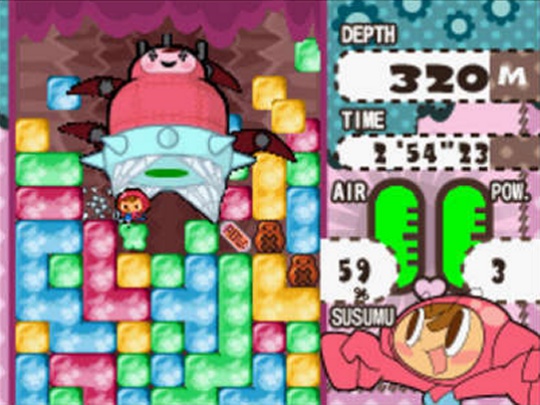
Tune into Part 2 for more games, possibly including this one!
And that's it for now. But this first batch of mini-reviews represents less than half of the current content of your reporter's flash cart, and the DS is currently guzzling a full power charge every day, so there's lots more essential information to disseminate. Remain alert!
|

